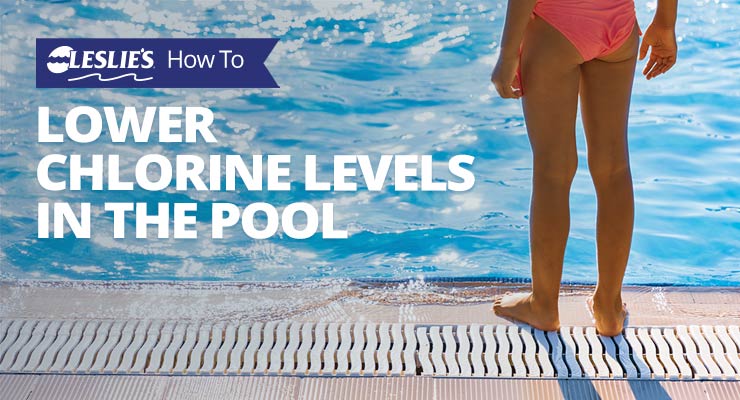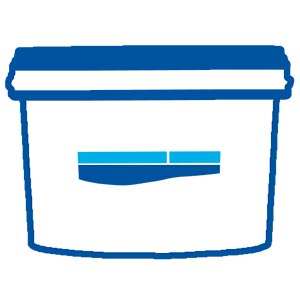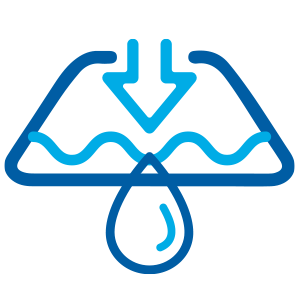
How to Lower Chlorine Levels in the Pool
If there’s one thing with which pool owners are familiar, it’s chlorine. Chlorine and pool water go together like two peas in a pod, because chlorine purifies the water and makes it suitable for swimming. When used in the correct doses, it’s a fairly inexpensive part of your pool upkeep routine. Sometimes, however, too much of a good thing can be a bad thing. Too much chlorine can take a fun swimming pool setting, and turn it into a not-so-great experience. Fortunately, too much chlorine in your pool can be easily corrected with a few simple tips and tricks. Keep reading to learn about the three ways to lower chlorine levels in your swimming pool:

Expose the pool to sunshine.

Add chlorine neutralizer chemicals.

Partially drain and refill the pool.
Why is My Chlorine Level High?
Believe it or not, high chlorine levels in a pool aren't uncommon. Anytime you shock the pool, you're raising chlorine levels above the ideal level to superchlorinate the water. This helps break down organic contaminants in the water. It's a key part of controlling algae, bacteria, and other unsavory microorganisms. But if you accidentally overdose the pool with chlorine shock, it can be harmful to both you and your swimming pool.
Critical Signs You Have Too Much Chlorine
Here’s a fun fact to start with: you cannot smell chlorine in a pool. Yes, you read that correctly. The fact is, if you're smelling a distinct chlorine aroma, you're actually smelling chloramines, which means there may not be enough chlorine in the pool.
You, alone, cannot determine whether or not the chlorine levels in your pool are too high or too low. But there are a few ways to tell you might be dealing with an over-chlorinated pool.
Have you ever stepped outside a pool, and immediately felt the effects of super-dry hair, irritated eyes, or itchy skin? In extreme cases, you might even experience respiratory problems or other symptoms after prolonged exposure to high chlorine levels. When this happens, it's a surefire indicator to investigate further. But there's a better way to check chlorine levels in the pool!
The best — and safest— way to safely check your chlorine levels is with a testing kit. There are many at-home water tests that can help you check the chlorine levels in your pool. Test kits can also check for other aspects of water chemistry, including Total Alkalinity and pH. According to the Centers for Disease Control and Prevention, a pH reading between 7.2–7.8 is ideal for optimum chlorine sanitation in a swimming pool.
How Do I Lower My Pool Chlorine Levels?
If chlorine levels are higher than 4.0 parts per million (ppm), there are a few ways you can lower the level of chlorine in your pool:
Expose the water to sunshine
An easy (and free!) way to dissipate chlorine in your pool is to let good ol’ Mother Nature do the work. Uncovering your pool and exposing the water to direct sunlight can help lower high chlorine levels in the pool. How is this possible? Simple! The sun's UV rays react with the chlorine in your pool, releasing chlorine gas into the atmosphere. If you use stabilizer or conditioner (Cyanuric Acid) in the pool, this method may not be as effective, and can take longer. The same holds true if you have a pool in a shaded yard that doesn't see much sunlight.
If you want to try this method, stop chlorinating your pool. Leave your pool uncovered, turn off or remove any chlorine dispensers, and keep an eye out on your chlorine levels with a testing kit. Just remember, if your chlorine levels fall into the ideal range of 2.0–4.0 ppm, then it’s time to resume regular chlorination. This will ensure continued sanitization of your pool.
BONUS TIP: Speaking of sunshine, warmer temperatures encourage bacteria growth, which can speed up chlorine consumption. If warmer weather is not in the forecast, look into other ways to help heat up the pool water.
Use a chlorine neutralizer
If you’re looking to fix the high levels of chlorine in a short amount of time, we recommend using a chlorine neutralizer. There are several chlorine neutralizers on the market, including sodium thiosulphate, sodium sulfite, and sodium metabisulfite, among others. These products reduce high levels of chlorine without altering Total Alkalinity or Calcium Hardness levels in your pool.
Add the neutralizer gradually to avoid removing too much chlorine at once. If this happens, you'll just have to readjust the levels again. Depending on the level of chlorine present in your pool, you may need to repeat this a few times to get back within recommended ranges.
Use ascorbic acid
Ascorbic acid, also known as good ol' vitamin C, is an all-natural chemical most commonly used for removing metal stains on pool surfaces. However, a side effect of this product is that it neutralizes chlorine. If you have a bottle of ascorbic acid, such as Natural Chemistry StainFree Extra Strength, you can use it to reduce chlorine levels in the pool at a rate of approximately 2.5 parts of ascorbic acid to 1 part neutralized chlorine.
Dilute pool water
Another solution in dealing with high chlorine levels is to partially drain and refill your swimming pool. However, this should only be considered as a last resort. This option can be helpful when the chlorine levels are exceedingly high and chemical treatments just aren’t cutting it — especially if you’re spending a lot of time and money trying to fix the issue at hand.
However, there are numerous disadvantages when going this route. Yes, draining and refilling your swimming pool will cut down on chlorine levels. But it will also lower other chemical levels in your water. When you refill the pool, you'll have to rebalance everything. Not only that, but draining the pool is a time-consuming process that costs time and money. Draining may not even be an option in some localities, or there may be restrictions on draining this water. Not to mention that superchlorinated water kills plants, so it can't just be dispersed in the yard. There's much to think about when considering whether to change the water or not. So, again, treat this as a last resort. Try the other avenues first!
While high chlorine levels aren't the most common problem with pool chemistry, it can happen. Remember to test your pool chemistry frequently to make sure your chlorine levels are within the ideal range of 2.0–4.0 ppm. If it's too low, add the correct dose of pool shock, using caution so you don't accidentally overdo it! Or, if levels are too high, you can lower the amount of chlorine in the water with any of the methods listed above. After all, keeping your pool chemistry balanced provides a more enjoyable swimming experience and a longer-lasting pool.
Have questions or need help? Bring a water sample to your local Leslie's for a free 10-point AccuBlue® water analysis and customized treatment plan. We can help you resolve any water balance issues that may be plaguing your pool.